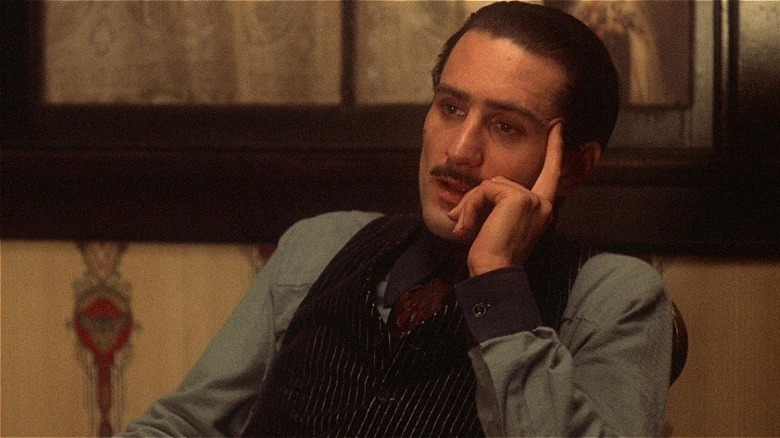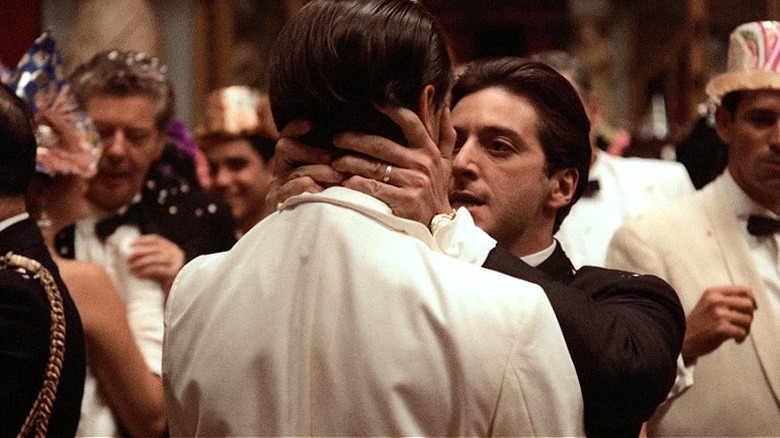The First Sequel To Win The Best Picture Oscar Is A Beloved Crime Epic
In 1974, Paramount Pictures released "The Godfather Part II," a prestige sequel featuring the original film's creative team and an ensemble cast led by Al Pacino, Robert De Niro, and Diane Keaton. It quickly rose to become, just like its predecessor, one of the most acclaimed movies of the 1970s, and in 1975 became the first sequel to win the Oscar for best picture.
This was a big deal, and not just because it continued the reign of success that launched with "The Godfather." In the 1970s, sequels were not as common as they are now, though they were still a key piece of the release calendar. Sequels were usually reserved for genre pictures meant to attract a wide, often younger, audience. They were reserved for monster movies, which began with films like "Bride of Frankenstein" in the 1930s, and adventure films, like the James Bond franchise.
In the world of prestige cinema, sequels were much rarer, but Paramount saw an opportunity to continue "The Godfather" story, and director Francis Ford Coppola saw an opportunity to exercise more creative control to create a different kind of follow-up film that would maintain the standard of quality set by "The Godfather." The result was not just a great sequel, not just an Oscar winner, but one of the best films of all time. So, let's take a closer look at how "The Godfather Part II" pulled it off.
Why The Godfather Part II was so successful
A key thing to remember about "The Godfather" saga is that Francis Ford Coppola had no interest in making a sequel, at least at first. "The Godfather" was released in 1972 to rave reviews, set box office records, and won three Oscars, including best picture, but for Coppola, it was a battle to get the film made his way in the first place. He didn't want to fight Paramount Pictures over a follow-up, but in "Godfather" terms, they made him an offer he couldn't refuse, which included more money and more creative control.
Armed with the clout of a hitmaking director and a cast that included new and returning characters in the story, Coppola and Mario Puzo set out to craft what would be a sequel and a prequel to "The Godfather," simultaneously. The ending of "The Godfather," which saw Michael Corelone take over for his late father Vito, was continued into the ensuing years. But "The Godfather Part II" also moved backward to New York City in the 1910s, where a young Vito Corleone (Robert De Niro) is out of a job thanks to the local crime bosses and turns to a life of crime himself, quickly becoming an important member of his community through power and influence.
Crucially, the film's parallel stories were built on opposing trajectories. Vito rose while Michael fell, Vito grew more principled and strong while Michael grew more compromised and weak. One family grew, while the other crumbled. Audiences couldn't get enough of it.
The legacy of The Godfather Part II
"The Godfather Part II"'s expansion of "The Godfather" timeline proved a hit with critics and audiences. It showed the story could continue with a new, original plot from Francis Ford Coppola and Mario Puzo, one that examined not just the rise and fall of organized crime but a very specific kind of American experience.
In 1975, "The Godfather Part II" doubled its predecessors Oscar tally with six wins, including another best picture statue, another best adapted screenplay statue, and a best director win for Coppola. To this day, it's one of only two sequels (the other is "The Lord of the Rings: The Return of the King") to win best picture, and it remains the only sequel to win the award while its predecessor also won.
While it didn't exactly launch a spate of sequels winning best picture, "The Godfather Part II" lives on in the public imagination as one of the rare sequels that is equal to or better than its predecessor. More than that, though, it expanded the scope of what sequels could do in Hollywood, as Coppola and Puzo delivered a story that built on the previous plot, but also added to the context of the first film. You can watch them together as a single piece of storytelling, and indeed a TV miniseries version of the story that cuts together both films, "The Godfather Saga," was released in 1977. It's a perfect sequel, one that filmmakers can still learn from today.


